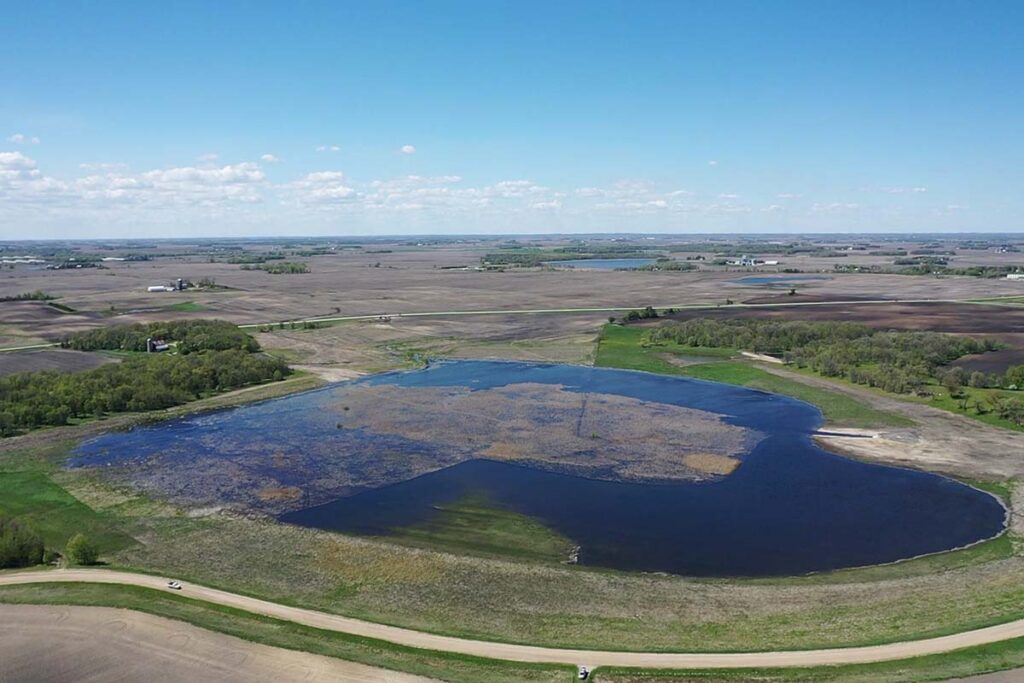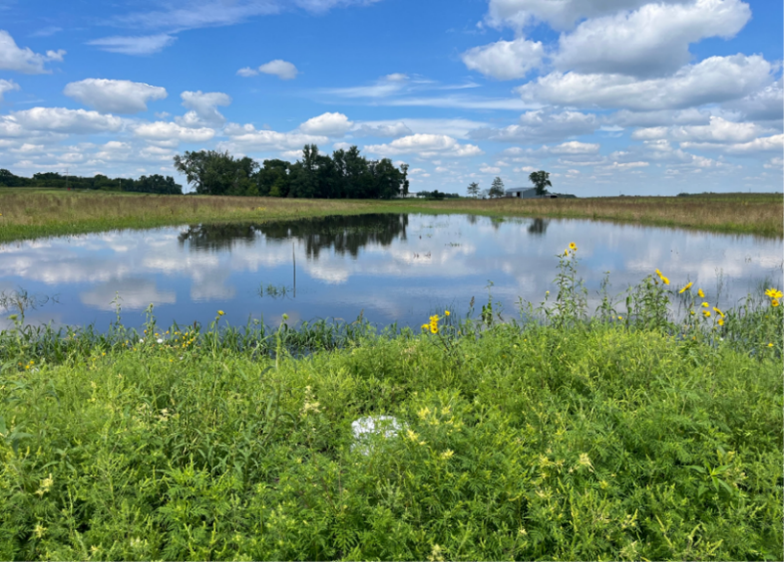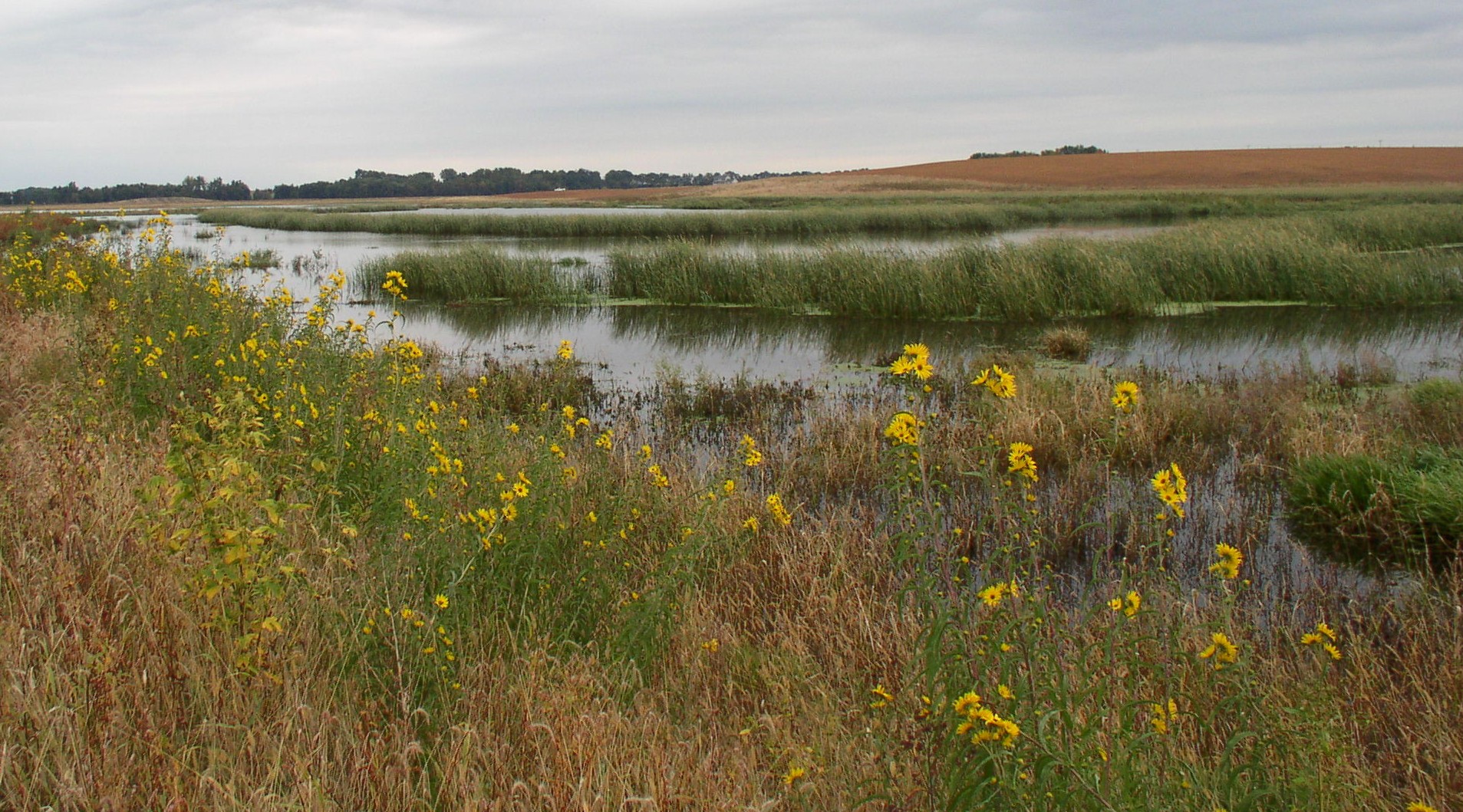Minnesota’s wetland restoration efforts are working to address the loss of critical habitat across the Prairie Pothole Region, with key projects at Butler Lake, Moore Slough Wetland Protection Area (WPA), and Herberger Lake Wetland Management Area (WMA). These initiatives, driven by partnerships among federal agencies, non-government conservation organizations, and private landowners, restore vital ecosystems that benefit wildlife, improve water quality, and provide public recreation opportunities.

Butler Lake - Meeker County
By Joe Genzel
Over the last decade, Ducks Unlimited (DU) has partnered with the U.S. Fish and Wildlife Service (USFWS) and Meeker County, Minnesota, to restore 66-acre Butler Lake. The lake, which once spanned 200 acres, was drained over a century ago through a concrete subsurface tile.
“After the lake was drained, the lakebed was carved up and the land was distributed accordingly to each bordering landowner,” said USFWS Project Leader Scott Glup. “When the old tile started to fail, Meeker County partnered with DU and USFWS to design and build a new water control structure on the lake outlet to restore water levels.”
Construction of the project was completed in late winter 2024, and subsequent spring rains completely refilled the basin. Waterfowl and other wetland-dependent wildlife began using the restored lake immediately. DU also restored four prairie pothole wetlands on the private land surrounding the lake.
The work was made possible by a group of private landowners who voluntarily enrolled their land in USFWS conservation easements, totaling 175 acres. Funding was provided through Minnesota’s Outdoor Heritage Fund, as recommended by the Lessard-Sams Outdoor Heritage Council, a North American Wetland Conservation Act (NAWCA) grant and DU Living Lakes Initiative Major Sponsors.
“Many folks outside of the state don’t realize this, but western Minnesota is a part of the Prairie Pothole Region, so the waterfowl habitat work we do here directly impacts breeding success,” said DU Manager of Conservation Programs John Lindstrom. “Partnering with the USFWS is critical to our conservation goals for this high-priority region because they manage so many public Waterfowl Production Areas and private conservation easements across the state.”
Butler Lake’s new control structure will keep water levels between 3 and 4 feet. Smaller wetlands and adjacent native upland grasses provide refuge and nesting cover for breeding pairs of ducks. Some of the restored grasslands will also provide sustenance for grazing cattle.
“DU is working with cattle ranchers throughout Minnesota to promote rotational grazing and other sustainable practices that benefit producers and waterfowl,” Lindstrom said. “Butler Lake is a good example of how producers, wetlands and native grasslands can fit well together.”
https://www.ducks.org/newsroom/prairie-pothole-upland-habitat-restored-in-western-minnesota-

Moore Slough WPA - Jackson County
By Jake Chronister
The Moore Slough WPA Project, located north of Spirit Lake in Jackson County, Minnesota, is a collaborative conservation initiative led by the U.S. Fish and Wildlife Service (USFWS), Pheasants Forever (PF), Ducks Unlimited (DU), the North American Wetlands Conservation Council, the Lessard-Sam’s Outdoor Heritage Council, and the Spirit Lake Protective Association. The project involves the acquisition and restoration of 195 acres of formerly drained wetlands and cropland, focusing on restoring a 76-acre shallow lake that has been drained since the 1970s.
The project’s primary goal is to restore water flow to the basin and install a water control structure, enabling periodic dewatering to manage invasive fish populations and encourage the growth of native plant species. Restoration efforts aim to rebuild quality habitat for migratory and breeding waterfowl by providing essential aquatic plants, invertebrates, nesting cover, brood-rearing areas, and critical stopover points during migration.
Beyond wildlife benefits, the project offers significant human and environmental advantages. The restored wetlands will improve water quality in nearby Spirit Lake and the Okoboji chain by filtering sediments and nutrients and helping mitigate local flooding. The restored land is also open to public recreation, supporting outdoor traditions and community engagement.
Native prairie seeding was completed in 2023 and vegetation is starting to establish. The DU-led shallow lake restoration began in Fall 2024, and as of May 2025, drainage tile is removed and dewatering pumps turned off for the first time in 55 years. Total cost of the land acquisition, upland prairie planting, and shallow lake restoration exceeded $2.6 million.
Inquiries can be directed to Regional Biologist Jake Chronister of Ducks Unlimited for further information.

Herberger Lake WMA - Todd & Douglas County
By Minnesota Department of Natural Resources
Completed in 2024, the Herberger Lake WMA Wetland Restoration Project focused on revitalizing wetland habitats across a 55-acre area containing 38 separate basins. The partnership included Minnesota Department of Natural Resources, Pheasants Forever, the Minnesota Land Trust, and the Sauk River Watershed District. This restoration initiative included multiple techniques such as sediment removal, berm construction, ditch filling, and drain tile removal, which enabled the WMA to retain up to 65 acre-feet of water at full capacity.
A key component of the project was the installation of water management infrastructure to support long-term ecological health and flexibility in habitat management. Multiple basins have drainage systems to mimic natural drawdowns. These allow managers to drain basins as needed for maintenance techniques such as mowing, disking, and roller chopping—crucial for preserving wetland quality and vegetation.
A bypass system was also created in one of the basins that experienced unusually rapid water accumulation. This system allows continuous water flow through a rock spillway to a downstream basin, dissipating the water’s energy and reducing the pressure on the vegetated spillway.
One significant accomplishment of the project was the rehabilitation of a 5-acre cattail and reed canary grass basin. After drainage and mowing, the basin now supports open water, enhancing habitat availability during the spring waterfowl pair-bonding season.
Over 2,500 feet of drainage ditches—some exceeding ten feet in depth—were filled as part of the restoration. This not only erased unsightly landscape scars and improved hunters’ safety but also contributed to the creation and reestablishment of several wetland basins.
The Herberger Lake WMA project has improved wetland conditions, enhanced wildlife habitat, and increased the area’s ecological and recreational value.

